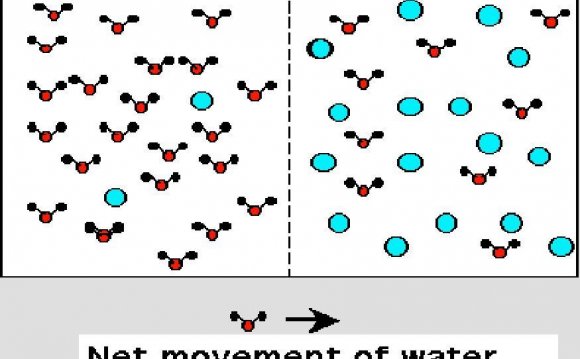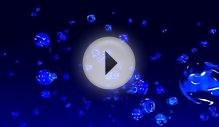
 Substances that must be able to enter a cell are water, oxygen, and nutrients. On TV medical dramas, you'll often see technicians administering a saline drip to a patient who has lost blood or is dehydrated. This saline solution maintains a specific concentration of dissolved substances in the blood and body fluids. When dehydrated, our concentration of dissolved substances increases, upsetting the balance in our cells. Water can freely move in and out of cells to maintain the same water pressure on both sides of the plasma membrane. Oxygen is important because cells are undergoing cellular respiration. A cell takes chemical bond energy and converts it to a form of energy that it can use-a molecule of ATP. ATP contains small amounts of energy appropriate to powering cellular processes. This process of energy conversion requires oxygen (we will discuss this in more detail in Lesson 4). For aerobic cellular respiration to occur inside this cell, oxygen must move through the plasma membrane.
Substances that must be able to enter a cell are water, oxygen, and nutrients. On TV medical dramas, you'll often see technicians administering a saline drip to a patient who has lost blood or is dehydrated. This saline solution maintains a specific concentration of dissolved substances in the blood and body fluids. When dehydrated, our concentration of dissolved substances increases, upsetting the balance in our cells. Water can freely move in and out of cells to maintain the same water pressure on both sides of the plasma membrane. Oxygen is important because cells are undergoing cellular respiration. A cell takes chemical bond energy and converts it to a form of energy that it can use-a molecule of ATP. ATP contains small amounts of energy appropriate to powering cellular processes. This process of energy conversion requires oxygen (we will discuss this in more detail in Lesson 4). For aerobic cellular respiration to occur inside this cell, oxygen must move through the plasma membrane.
Some nutrients enter freely; others are controlled. Cells must also export the products that they make. (We'll discuss how cells make proteins in Lesson 7.) The cells in your liver are amazing: they make many, many proteins that leave the liver cells to be transported to cells in other parts of your body. Waste products must also leave a cell. For instance, during cellular respiration, carbon dioxide is released as a waste product. It goes back into our blood stream and eventually is exhaled from our lungs. So cells must interact with their environment yet maintain fairly constant internal conditions. There are three ways that substances move across the plasma membrane: (1) diffusion, (2) facilitated diffusion, and (3) active transport.
For instance, during cellular respiration, carbon dioxide is released as a waste product. It goes back into our blood stream and eventually is exhaled from our lungs. So cells must interact with their environment yet maintain fairly constant internal conditions. There are three ways that substances move across the plasma membrane: (1) diffusion, (2) facilitated diffusion, and (3) active transport.
Diffusion
 The simplest method of moving substances across the membrane is diffusion, the random movement of particles from an area of higher concentration to an area of lower concentration. Diffusion follows a concentration gradient (Figure 3.4) and will occur across the plasma membrane as long as there is no restriction (e.g., size or charge of molecule). Non-polar lipids and small molecules such as oxygen and carbon dioxide are able to pass freely through the membrane. For example, because oxygen is used for cellular respiration, there is always a higher oxygen concentration outside the cell and a lower concentration inside. As oxygen follows this gradient from higher to lower concentration, oxygen molecules are always diffusing into the cell. Carbon dioxide also undergoes diffusion but in the opposite direction because there is always a higher concentration of carbon dioxide inside than outside the cell. Other small molecules, like ethanol, also can diffuse freely through the plasma membrane, which is why alcohol hits your system fairly quickly: it diffuses from your digestive system into your bloodstream and then is carried to all of your cells. It affects these fairly rapidly and evenly, diffusing into them until the cellular concentration is approximately equal to that in your bloodstream. Diffusion does not require the input of energy on the part of the cell.
The simplest method of moving substances across the membrane is diffusion, the random movement of particles from an area of higher concentration to an area of lower concentration. Diffusion follows a concentration gradient (Figure 3.4) and will occur across the plasma membrane as long as there is no restriction (e.g., size or charge of molecule). Non-polar lipids and small molecules such as oxygen and carbon dioxide are able to pass freely through the membrane. For example, because oxygen is used for cellular respiration, there is always a higher oxygen concentration outside the cell and a lower concentration inside. As oxygen follows this gradient from higher to lower concentration, oxygen molecules are always diffusing into the cell. Carbon dioxide also undergoes diffusion but in the opposite direction because there is always a higher concentration of carbon dioxide inside than outside the cell. Other small molecules, like ethanol, also can diffuse freely through the plasma membrane, which is why alcohol hits your system fairly quickly: it diffuses from your digestive system into your bloodstream and then is carried to all of your cells. It affects these fairly rapidly and evenly, diffusing into them until the cellular concentration is approximately equal to that in your bloodstream. Diffusion does not require the input of energy on the part of the cell.
Figure 3.4. Diffusion of Sugar in Water
©The McGraw-Hill Companies, Inc. Permission granted for reproduction
Osmosis
Osmosis is the term for a special type of diffusion, the diffusion of water, and is based on the concentration of dissolved substances (solutes), either in the fluid within the cell or in your blood stream, which cannot cross the membrane. In the figure below (Figure 3.5), a beaker is shown to demonstrate the movement of water within a cell by osmosis.
YOU MIGHT ALSO LIKE












